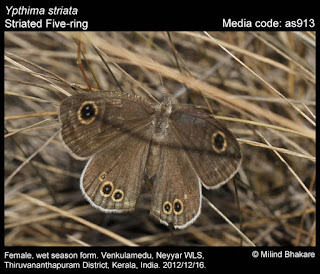Stiated Five Ring / Nilgiri Jewel Four Ring
Ypthima striata
|
Malayalam
Name |
: |
രത്ന
നേത്രി |
|
Common
Name |
; |
Striated
Five Ring /
Nilgiri Jewel Four Ring |
|
Order |
: |
Lepidoptera |
|
Super
Family |
: |
Papilionoidae
(Butterflies) |
|
Family
|
: |
Nympalidae |
|
Sub
Family |
: |
Satyrinae |
DISTRIBUTION : The South India
STATUS: Endemic to Western Ghats
HABITAT : Southern slopes of the Nilgiris,
2000 - 4000 ft.
HABITS :
IDENTIFICATION
FEATURES:
Medium-sized brown butterfly with wingspan of 30 to 45 mm.
Wet-season form: Description : Male. Upperside, both wings uniform dark brown. Forewing with a distinct bipupilled black ocellus outlined with yellowish- brown. Hindwing with two ocelli faintly pupilled and with yellow iris, situated between the median nervules. Underside, both wings white with numerous distinct brown striae. Forewing with one bipupilled ocellus larger and brighter than on the upperside ; crossed by two brown fascias, one submarginal, one discal, nearly meeting at the hinder angle. Hindwing with a double ocellus on a short brown fascia near the apex, and three linearly disposed towards the anal angle, the one nearest it bipupilled, these three ocelli situated on a brown fascia, and all the ocelli large and distinct ; a fascia crossing the wing beyond the cell from the costa to the inner margin, and a less distinct one near the base of the wing. Female ; only differs in being rather larger and paler than the male. Male ; with no trace of the patch of dense scales on the upperside of the forewing.
Dry-season form: Male. Upperside, forewing with a slight patch of dense scales on the median nervure ; with a very small and indistinct ocellus. Under- side, both wings with the fasciae indistinct and the striae smaller and denser. Hindiving, with the ocelli much smaller than in the wet-season form, the double ocellus near the apex separated into two ocelli, the upper one minute, and the bipupilled ocellus near the anal angle forming a double ocellus. Female. Upperside, forewing differs from the male in having a large and distinct black bipupilled ocellus with yellow iris. Underside, both wings with the fasciae more prominent, but not as much so as in the wet-season form.
The wet-season form occurs commonly at about 3000 ft. on the southern slopes of the Nilgiris in August, and the dry-season form in December and January.
SIMILAR SPECIES
:
Similar to Nilgiri Four Ring, Common Four Ring
LARVAL HOST PLANTS
Axonopus compressus, Setaria barbata (Poaceae).
LIFE CYCLE
MORE IMAGES
 |
കേരള വനം വന്യജീവി വകുപ്പ് മാങ്കുളം ഡിവിഷൻ |









Comments
Post a Comment